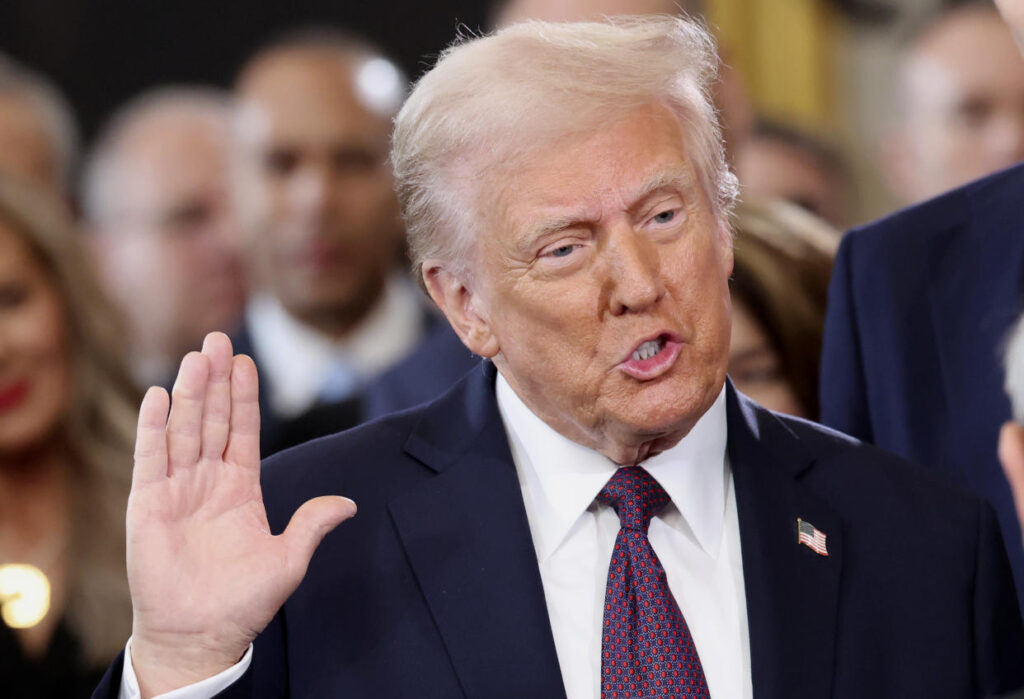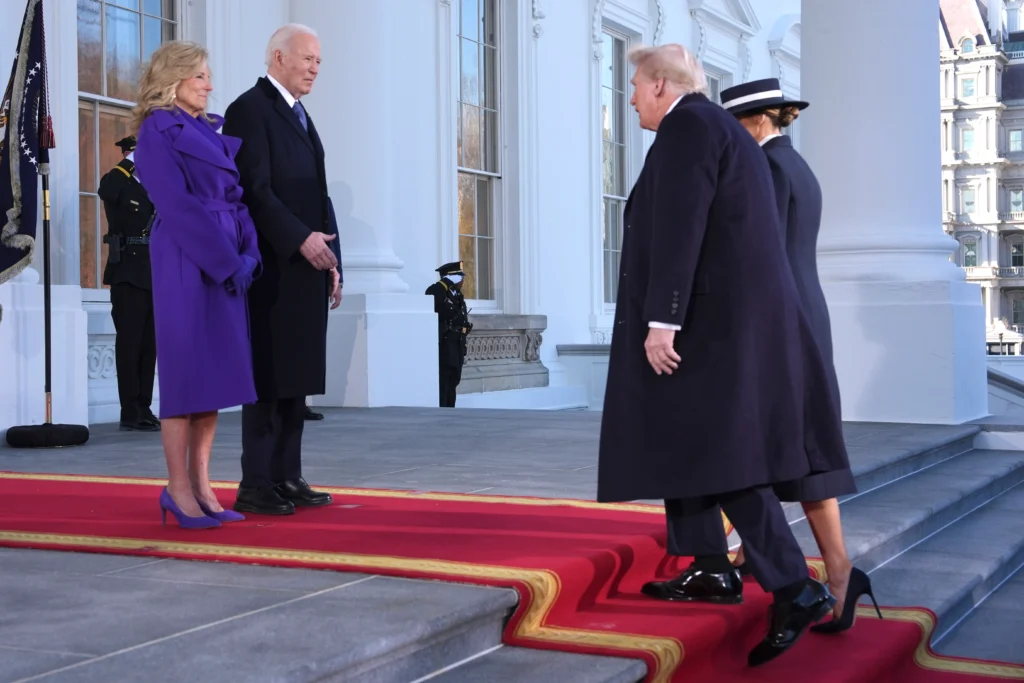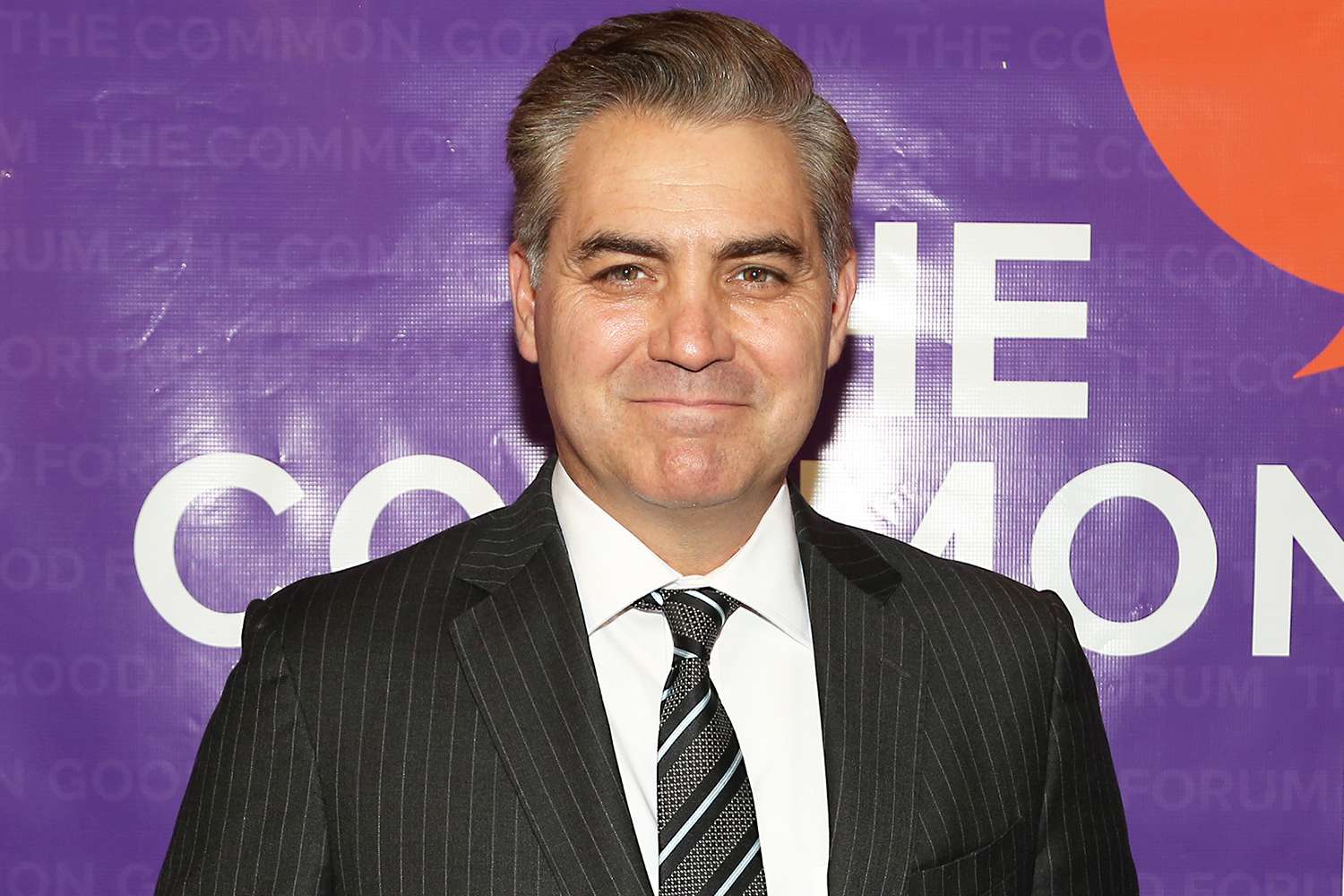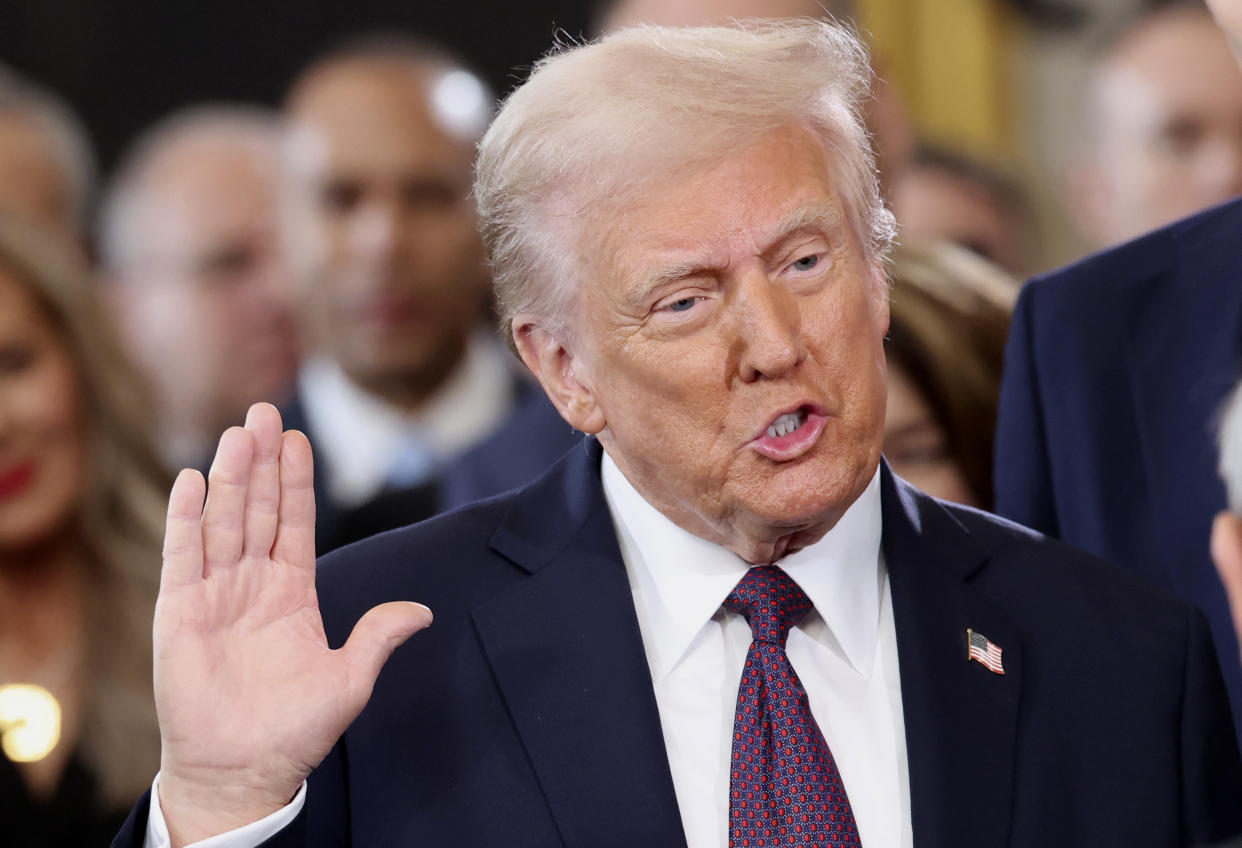
Trump 2025 Inauguration : Explore the highlights of President Donald Trump’s 2025 inauguration, including his inaugural address themes, immediate policy initiatives, and the day’s significant events.
Table of Contents
On January 20, 2025, Donald Trump was inaugurated as the 47th President of the United States, marking a historic return to the White House after a previous term from 2017 to 2021. The inauguration, held indoors due to intense cold, was a blend of tradition, policy declarations, and notable attendees, reflecting the nation’s current political and social climate.
The Inauguration Ceremony
The ceremony commenced at noon local time in the Capitol Rotunda, relocated from the National Mall because of severe weather conditions. Vice President JD Vance took the oath first, followed by President Trump, who was sworn in using two Bibles: his personal copy and the Lincoln Bible, continuing a tradition from his first inauguration.
Performances included Carrie Underwood singing “America the Beautiful” and the Village People, adding a unique touch to the event. Former presidents, including Barack Obama, attended, though Michelle Obama was absent. President Joe Biden also attended, upholding the tradition of a peaceful transfer of power.
Key Themes of the Inaugural Address
In his address, President Trump emphasized a return to “common sense” and an end to political correctness, promising to create a proud and free nation. He declared a “new golden age” for America, focusing on rebalancing justice, restoring safety, and reclaiming the nation’s sovereignty.
Policy Initiatives Announced
President Trump outlined several immediate policy actions:
- National Emergency at the Southern Border: He declared a state of emergency to address immigration concerns, aiming to enhance border security and implement stricter immigration policies.
- Withdrawal from the Paris Climate Agreement: Trump announced the U.S. withdrawal from the agreement, citing the need to prioritize American interests and economic growth.
- Establishment of the External Revenue Service: Aimed at overhauling the tax system, this new agency is intended to streamline tax collection and enforcement.
- Implementation of Tariffs: Significant tariffs on goods from Mexico, Canada, and China were introduced to encourage domestic production and protect American industries.
- Space Exploration Initiative: Trump pledged to prioritize space exploration, aiming to plant the American flag on Mars, signaling a renewed commitment to NASA and space endeavors.
Reactions and Controversies
The inauguration highlighted both unity and divisions within the country. Media coverage varied significantly, with some outlets emphasizing bipartisan moments and others critiquing the partisan nature of the address. High-profile tech figures, including Elon Musk and Mark Zuckerberg, were present, suggesting their influence in the current political landscape.
Controversies included the removal of a government health website providing abortion information and protests in Mexico City against Trump’s immigration policies. Additionally, the tech industry’s substantial financial contributions to Trump’s inauguration raised concerns about potential corruption and the intertwining of government and tech interests.
President Trump’s inauguration day was a significant event, marking his return to the presidency with promises of transformative policies and a focus on “America first.” The day’s events reflected the nation’s complexities, with moments of unity, policy declarations, and underlying controversies shaping the path forward.
President Trump was inaugurated for the second time Monday afternoon, becoming one of just two U.S. presidents to return to the White House after losing reelection four years earlier. His reascension to the highest office in the land has already set the tone for what promises to be a uniquely bold and contentious second term. Below is a comprehensive analysis of the themes, implications, and controversies surrounding his return.
Trump’s Inaugural Address: A Vision of “Thrilling New Horizons”
In his inaugural speech, Trump declared, “The golden age of America begins right now,” striking a triumphant tone that resonated with his loyal base and set the stage for his ambitious agenda. Unlike the somber, divisive tone of his 2017 inaugural address, which focused on “American carnage,” Trump this time pivoted to a message of growth, expansion, and reclaiming what he views as America’s rightful place at the pinnacle of global power.
Trump’s rhetoric leaned heavily on the concept of a new “Manifest Destiny,” a term historically tied to 19th-century westward expansion. However, in Trump’s vision, this “Manifest Destiny” extends to outer space, global influence, and economic supremacy. Among the striking proposals outlined were:
- Planting the American flag on Mars as part of an ambitious space program.
- “Taking back” control of the Panama Canal to restore U.S. strategic dominance.
- Rechristening the Gulf of Mexico as the “Gulf of America.”
- Restoring the name of Alaska’s Denali back to Mt. McKinley, a move symbolic of traditionalist values.
Trump’s rhetoric captured his unique brand of political audacity, aimed at rallying supporters while intimidating rivals. “In America, the impossible is what we do best,” he proclaimed, framing his return as a testament to perseverance and destiny.
The Political Landscape: A MAGA-Dominated GOP
One of the most significant shifts in the political landscape over the past eight years has been the transformation of the Republican Party. In 2017, Trump faced resistance not just from Democrats but also from within his own party. Establishment figures like House Speaker Paul Ryan and Senator Mitt Romney openly questioned his policies and leadership style. Today, that resistance has all but disappeared.
The GOP has largely been remade in Trump’s image, with MAGA-aligned figures dominating key leadership roles. Prominent Trump critics, such as Liz Cheney, Mitt Romney, and Adam Kinzinger, have either retired or been ousted in primaries. The Republican National Committee’s platform now mirrors Trump’s priorities, emphasizing nationalism, border security, and a confrontational approach to foreign policy.
This consolidation of power within the GOP has given Trump a freer hand to pursue his agenda. It also reflects his ability to transform political opponents into allies or render them politically irrelevant. His return to power is seen by many as a definitive moment in the party’s evolution, solidifying its identity as the party of Trump.
The Resistance’s Shift in Strategy
In contrast to the widespread protests and organized resistance that greeted Trump’s first inauguration, his second inauguration saw a much more subdued response. In 2017, nearly 600,000 demonstrators flooded Washington, D.C., making it the largest single-day protest in American history. This time, protests were smaller and less organized.
The diminished resistance reflects several factors:
- Strategic Reevaluation: Many progressive leaders, including former Democratic National Committee Chair Donna Brazile, have acknowledged that focusing solely on opposing Trump proved ineffective. “Focusing all of [our] energy on one man failed to make the difference,” Brazile admitted. Moving forward, the resistance aims to adopt a broader strategy that focuses on local governance, grassroots organizing, and policy advocacy.
- Demoralization: Trump’s popular-vote victory in the 2024 election shocked many Democrats, forcing a reckoning within the party. The failure to galvanize voters in key swing states has led to internal divisions and debates about the party’s future direction.
- Adaptation by Corporations: Major corporations, particularly in Silicon Valley, have adjusted to Trump’s policies and rhetoric. Tech leaders like Mark Zuckerberg were notably present at the inauguration, signaling a shift in their approach to working with the administration. Many have recalibrated their priorities to align with Trump’s agenda, prioritizing regulatory concessions and market access over ideological opposition.
Policy Priorities: What to Expect in Trump’s Second Term
Trump’s inaugural address provided several clues about his policy priorities for the next four years. Here’s a closer look at what to expect:
1. Space Exploration and Technological Dominance
Trump’s call to “plant the Stars and Stripes on the planet Mars” signals a renewed emphasis on space exploration. During his first term, he established the Space Force as a new branch of the military. In his second term, he aims to accelerate NASA’s Artemis program and foster private-sector innovation in space technology. By framing space exploration as a matter of national pride and security, Trump is likely to increase funding and support for these initiatives.
2. Economic Nationalism
Trump’s second term will likely continue his focus on “America First” economic policies. This includes renegotiating trade deals, imposing tariffs on foreign competitors, and incentivizing domestic manufacturing. His promise to “expand our territory” and “build our cities” suggests a renewed focus on infrastructure development, potentially funded through public-private partnerships.
3. Immigration and Border Security
Immigration has been a cornerstone of Trump’s political platform. In his second term, he is expected to push for even stricter border controls, including the completion of the U.S.-Mexico border wall. He may also revisit controversial policies like travel bans and increased deportations, framing them as necessary for national security.
4. Foreign Policy and Military Strength
Trump’s reference to “taking back” the Panama Canal highlights his interest in reasserting American influence abroad. Expect a more aggressive stance toward China, as well as efforts to renegotiate defense agreements with NATO allies. Trump’s vision of a “growing nation” includes expanding military capabilities and leveraging economic power to reshape international relations.
5. Cultural and Symbolic Moves

Trump’s push to rename Denali back to Mt. McKinley reflects his broader cultural agenda. These symbolic gestures resonate with his base, reinforcing themes of tradition and national pride. Expect similar initiatives aimed at reshaping America’s cultural narrative.
Challenges Ahead
Despite his confident rhetoric, Trump faces significant challenges in his second term. These include:
- Deepening Partisan Divisions: While Trump has solidified his support among Republicans, he remains deeply polarizing. Bridging the partisan divide will be a formidable task.
- Economic Uncertainty: The global economy is facing headwinds, including inflation and supply chain disruptions. Trump’s economic policies will need to address these challenges while delivering on his promises of growth and prosperity.
- Geopolitical Tensions: From Russia’s aggression in Eastern Europe to China’s growing influence, Trump will need to navigate a complex international landscape. His confrontational style may complicate diplomatic efforts.
- Legal and Ethical Scrutiny: Trump’s first term was marred by investigations and controversies. His second term is unlikely to be free from legal and ethical challenges, particularly as Democrats seek to hold him accountable.
Conclusion
Trump’s return to the White House marks a historic moment in American politics. His vision for a “thrilling new era of national success” reflects his trademark ambition and willingness to defy convention. Whether he can deliver on his promises remains to be seen. As the nation braces for another four years of Trump’s leadership, one thing is certain: the next chapter in America’s story will be anything but predictable. visit THENEWSIFY for more news









Leave a Reply